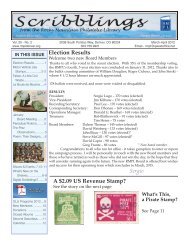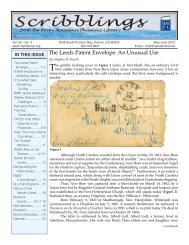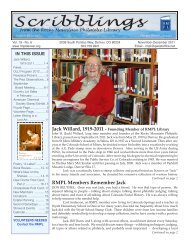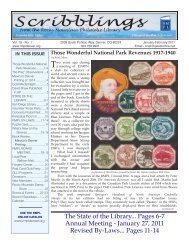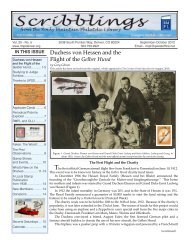Jul/Aug 2012 - Rocky Mountain Philatelic Library
Jul/Aug 2012 - Rocky Mountain Philatelic Library
Jul/Aug 2012 - Rocky Mountain Philatelic Library
Create successful ePaper yourself
Turn your PDF publications into a flip-book with our unique Google optimized e-Paper software.
Ron Mitchell’s Denver Eagle Book<br />
Wins Third Gold Medal<br />
Once more an RMPL published book has won gold medals<br />
in each of the three most prominent philatelic literature<br />
competitions in the country.<br />
Ron Mitchell’s Mexico’s Denver Printing of 1914, in<br />
addition to winning gold, also won the Reserve Grand<br />
Award for Literature, as well as the APS Award for Research<br />
Literature.<br />
Ron’s gold medal at NAPEX, added to his gold medals<br />
at last year’s CHICAGOPEX and STAMPSHOW, brings the<br />
RMPL six gold medals for its two recent publications.<br />
The earlier award winner was our first publication<br />
Camp Genter, Colorado Ghost Town Mail.<br />
Our congratulations to Ron for his outstanding work.<br />
The RMPL will be printing a second run of 50 copies of the<br />
book to meet demand. Anyone wishing to purchase a copy<br />
please contact Sergio Lugo to reserve it.<br />
And if you would like to publish a book which you’ve<br />
written, please consider the RMPL. We’ll provide you with<br />
a writer’s guide and the publications committee will work<br />
with you to produce the very best product the library can<br />
publish. Contact Sergio for further details.<br />
A third book by the RMPL recently published is Peter<br />
Bergh’s Danish Ore Bicolor Issues now available at the library.<br />
Visit the RMPL Web Page<br />
www.rmpldenver.org<br />
Read all back issues of Scribblings<br />
since January 2008 online<br />
Scribblings<br />
Coil Waste - Again<br />
by Joe Lambert<br />
FAKES<br />
The picture shows a good<br />
example of a manufactured<br />
coil waste item. In this<br />
instance, Scott #494, a 3 cent<br />
Type II coil, cat. $21.50, has<br />
been made into something<br />
looking a lot like Scott #541,<br />
a perf. 11x10 coil waste item,<br />
cat. $100. Note the straight<br />
edge of the top perfs, and<br />
the slight decrease in hole<br />
depth as the perfs move to<br />
the right. The bottom edge<br />
perfs are slightly more realistic looking, but, both top<br />
and bottom, the holes do not gauge correctly. (The<br />
Specialist, or Kiusalas, gauge is excellent for these<br />
situations- more on this at a later date).<br />
This is a mediocre #494 made into a pretty good<br />
looking #541 (for this)- remember that the stamps<br />
selected by the Bureau of Engraving and Printing for<br />
coil waste manufacture were typically, by the Bureau’s<br />
admission, badly centered. The presumed end product,<br />
#541, is not a rarity or punitively expensive- this is<br />
the risk that one takes with some frequently faked<br />
items- that the item is not so expensive that the cost of<br />
certification is necessarily in line with the value of the<br />
item. Be sure that you are comfortable with the origin<br />
of such items. They were experimental and were sold<br />
only to vending machine operators.<br />
This experiment was of limited time (mostly<br />
in 1908) and of limited scope (in the case of #322,<br />
only 36,500 were issued). Moreover, according to<br />
Armstrong’s United States Coil Issues of 1906-38. “Coils<br />
were a new thing, and at first, did not receive a heartwarming<br />
greeting. Collectors and dealers maintained<br />
the attitude that a coil was even worse than a straight<br />
edge since two sides lacked perforations. Therefore,<br />
it was the general consensus that coils were of no<br />
philatelic value. How things have changed!!!<br />
This particular fake fails for a few reasons - it is<br />
too short, it is not the right color, and it is not the right<br />
type of this stamp (see Armstrong, op.cit. regarding<br />
the last two of these).<br />
Flat plate coils are undoubtedly the most<br />
frequently faked items in U.S. philately - even the<br />
lowest cataloged ones are very often faked. Beware<br />
always - and most especially beware of the rarities - of<br />
which very, very few genuine examples remain. There<br />
are many fakes out there which are considerably more<br />
deceptive than the example here- which is so silly and<br />
off the wall as to deserve its own picture and article.<br />
Page 10 11 <strong>Jul</strong>y-<strong>Aug</strong>ust <strong>2012</strong>




